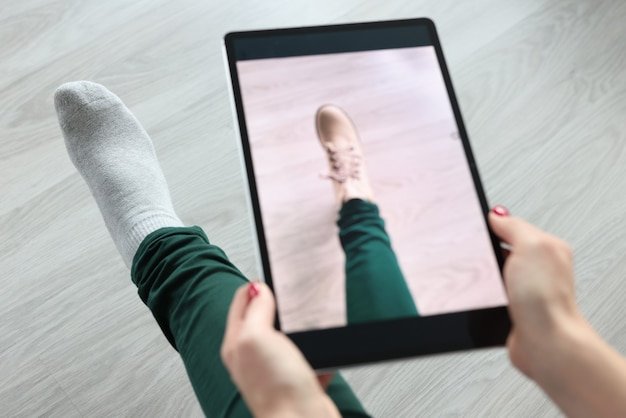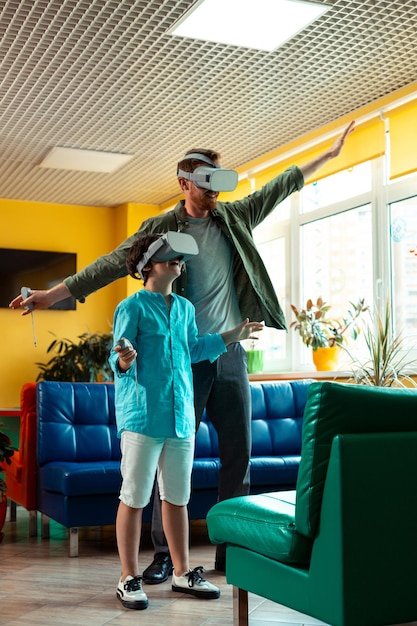Tech-enhanced shopping in the US is revolutionizing online haul experiences through the integration of augmented reality (AR) and virtual reality (VR), offering immersive and interactive ways for consumers to visualize products, try them virtually, and make more informed purchasing decisions from the comfort of their homes.
Imagine trying on clothes without leaving your living room or visualizing furniture in your home before you buy it. This is the reality of **tech-enhanced shopping** in the US, where AR and VR are transforming the online haul experience.
The Rise of Immersive Shopping Experiences
The retail landscape is constantly evolving, and in the US, **tech-enhanced shopping** is taking center stage. Augmented reality (AR) and virtual reality (VR) are no longer futuristic concepts but practical tools retailers are using to create more engaging and personalized shopping experiences.
These technologies allow customers to interact with products in ways that were previously impossible, bridging the gap between the online and offline shopping worlds.
What is Augmented Reality (AR) in Retail?
AR overlays digital information onto the real world, typically through a smartphone or tablet. In retail, this means customers can use their devices to see how furniture would look in their homes or try on makeup virtually.
What is Virtual Reality (VR) in Retail?
VR, on the other hand, creates a completely immersive digital environment. Shoppers can use VR headsets to enter virtual stores and browse products as if they were physically there.

Here are some of the ways AR and VR are enhancing the shopping experience:
- Virtual Try-Ons: Customers can virtually try on clothing, accessories, and makeup.
- Product Visualization: AR allows shoppers to see how products would look in their homes or offices.
- Interactive Catalogs: Catalogs come to life with AR, offering 3D models and additional product information.
- Virtual Showrooms: VR creates immersive shopping environments where customers can explore products and brands.
The adoption of AR and VR is changing how consumers in the US perceive and interact with online shopping, making it more experiential and convenient.
Benefits of AR/VR Integration in Online Shopping
Integrating AR and VR into online shopping offers numerous benefits for both consumers and retailers. These technologies enhance the shopping experience, improve customer satisfaction, and drive sales.
For consumers, AR and VR provide a more engaging and informative way to shop, while for retailers, they offer opportunities to differentiate themselves from competitors and create stronger customer relationships.
Consider these benefits of integrating AR/VR tech into your online shopping strategy.
Improved Customer Engagement
AR and VR create more interactive and engaging shopping experiences. By allowing customers to virtually try on products or visualize them in their environment, retailers can capture their attention and keep them interested.
Increased Purchase Confidence
One of the biggest challenges of online shopping is the inability to physically interact with products. AR and VR address this issue by providing virtual experiences that help customers make more informed purchasing decisions, increasing their confidence.

Reduced Return Rates
By allowing customers to visualize and interact with products realistically, AR and VR can help reduce return rates. Customers are more likely to be satisfied with their purchases when they have a clear and accurate understanding of what they are buying.
Enhanced Brand Loyalty
Retailers that embrace AR and VR are seen as innovative and customer-centric. This can lead to increased brand loyalty as customers appreciate the added value and personalized experiences these technologies provide.
Therefore, the integration of AR/VR can enhance a business in more ways than one, offering a wide range of benefits. The most important thing is execution.
Examples of AR/VR Applications in US Online Shopping
Several US retailers have already begun to successfully integrate AR and VR into their online shopping experiences. These examples highlight the diverse ways these technologies can be used to enhance the customer journey.
From virtual try-ons to interactive product visualizations, these applications are transforming how consumers shop online.
Sephora Virtual Artist
Sephora’s Virtual Artist app allows customers to virtually try on makeup using AR. Users can experiment with different shades and products to find the perfect look without ever physically applying the makeup.
IKEA Place
IKEA Place uses AR to let customers visualize furniture in their homes before they buy it. The app allows users to virtually place 3D models of IKEA products in their rooms, ensuring they fit and look good with existing decor.
Warby Parker Virtual Try-On
Warby Parker offers a virtual try-on feature that lets customers see how different styles of glasses would look on their face using AR. This helps customers choose the perfect frames from the comfort of their home.
How about this example of AR/VR technology in physical stores.
- Rebecca Minkoff: Uses connected mirrors in dressing rooms to allow shoppers to try on different outfits and accessories virtually.
- Lowe’s: Has an AR app that helps customers measure spaces and visualize how appliances and decor items would look in their homes.
- Uniqlo: Offers interactive mirrors that let shoppers experiment with different colors and styles of clothing.
These retailers are leading the way in exploring the potential of AR and VR to create more engaging and personalized shopping experiences for consumers in the US.
Challenges and Considerations for Implementation
While the benefits of integrating AR and VR into online shopping are clear, there are also challenges and considerations that retailers need to address. These include technology costs, user adoption, and data privacy.
Overcoming these challenges is essential for successful implementation and maximizing the potential of these technologies.
Technology Costs
Developing and implementing AR and VR applications can be expensive. Retailers need to invest in hardware, software, and skilled developers to create high-quality experiences. However, the long-term benefits of increased sales and customer loyalty can outweigh these initial costs.
User Adoption
Not all customers are familiar or comfortable with AR and VR technologies. Retailers need to educate their customers about the benefits of these experiences and make them easy to use. Providing clear instructions and intuitive interfaces can help drive adoption.
Data Privacy
AR and VR applications often collect data about customer interactions and preferences. Retailers need to ensure they are transparent about how this data is being used and that they comply with data privacy regulations. Building trust with customers is crucial for long-term success.
Additionally, scalability can be a challenge, making sure the systems can manage increased traffic and diverse product ranges.
By carefully considering these factors and implementing appropriate strategies, retailers can overcome the challenges and unlock the full potential of AR and VR in online shopping.
The Future of Shopping Hauls: AR/VR Innovations
The future of shopping hauls is undoubtedly linked to the continued innovation and adoption of AR and VR technologies. As these technologies become more advanced and accessible, they will play an even greater role in shaping the online retail experience.
Consumers can expect to see more personalized and immersive shopping experiences that blur the lines between the physical and digital worlds.
Advancements in AR Technology
AR technology is becoming more sophisticated, with improved tracking, better image recognition, and enhanced realism. This means customers can expect more seamless and immersive virtual try-on experiences and product visualizations.
Growth of VR Commerce
VR commerce is also poised for growth, with more retailers creating virtual showrooms and interactive shopping environments. As VR headsets become more affordable and user-friendly, more consumers will have access to these experiences.
Personalized Shopping Experiences
AR and VR technologies enable retailers to create more personalized shopping experiences tailored to individual preferences and needs. By analyzing customer data and interactions, retailers can offer customized product recommendations and virtual experiences.
In retail, trends like live shopping, AI-powered recommendations, and sustainable practices are revolutionizing the online haul experience. It’s set to be quite impressive.
The synergy between technology and consumer behavior is reshaping how we discover, interact with, and purchase products online, promising a personalized and seamless shopping experience.
| Key Aspect | Brief Summary |
|---|---|
| 📱 AR Apps | Overlays digital elements onto the real world via smartphones. |
| 🥽 VR Experience | Creates immersive, virtual environments for shoppers. |
| 🛍️ Benefits | Enhances engagement, confidence, and reduces returns for boosted brand loyalty. |
| 🚀 Future Trends | Personalized shopping journeys. Enhanced AR technology. The rise of VR commerce. |
Frequently Asked Questions
▼
▼
▼
▼
▼
Conclusion
In conclusion, the integration of AR and VR into online shopping in the US represents a significant shift in how consumers interact with brands and products. As technology continues to advance, these immersive experiences will become even more prevalent, offering personalized and engaging shopping hauls that enhance customer satisfaction and drive retail innovation.